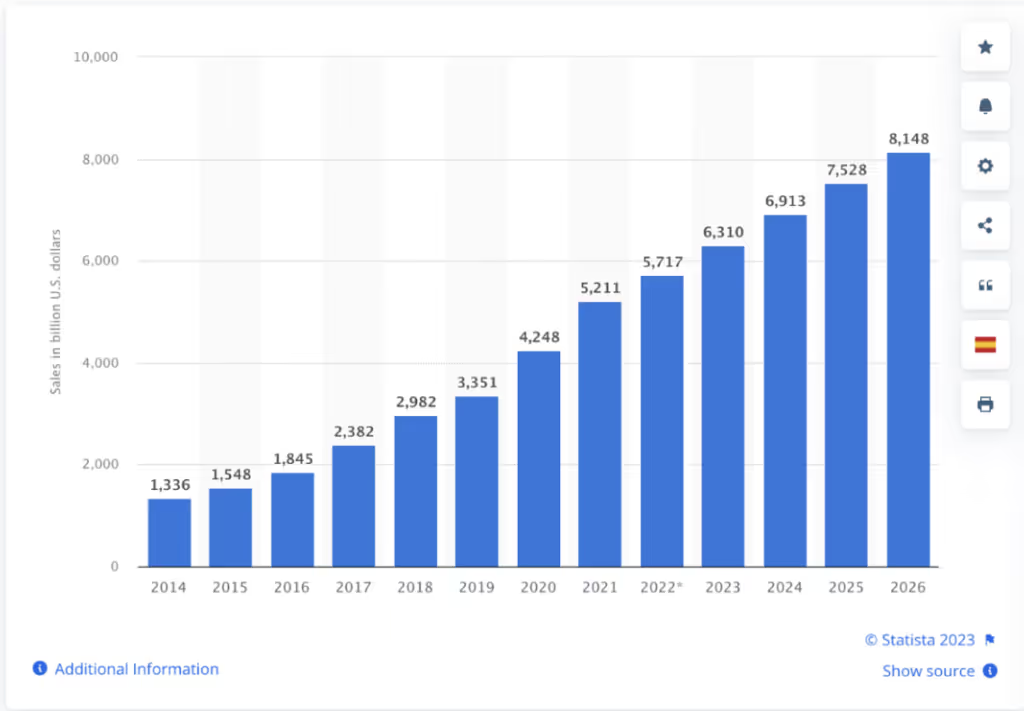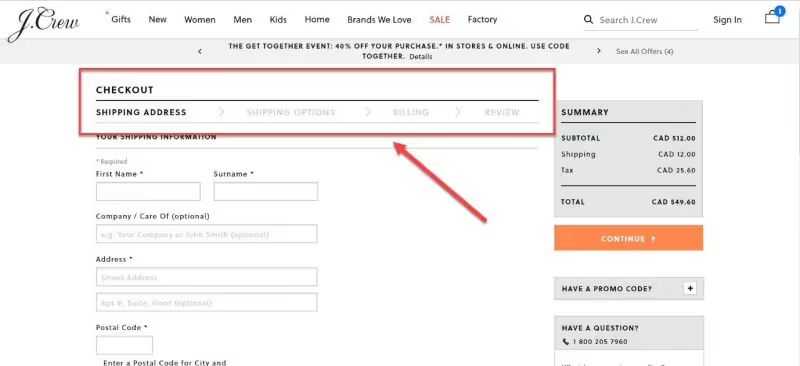Ecommerce KPIs and metrics you should track for your online store

In a digital era where ecommerce sales are projected to reach $8.1 trillion by 2026, understanding and effectively monitoring ecommerce KPIs can significantly influence your market positioning and overall ecommerce business health. This dynamic landscape demands not only constant monitoring of ecommerce performance metrics but also a strategic selection and utilization of the right ecommerce KPIs.
This article delves deep into the realm of KPIs for ecommerce businesses, underscoring their notable role in shaping successful online business strategies and business growth. With a focus on data-driven decision-making, we'll explore how to judiciously select KPIs that align with your business's strategic objectives and market trends.

The strategic importance of ecommerce KPIs
A KPI for ecommerce serves as a navigational compass, guiding and informing the decision-making process at every turn. When effectively harnessed, it offers a clear snapshot of an online store's performance and provides predictive insights crucial for planning a business’s online presence.
Precision in business decision-making
Ecommerce KPIs empower businesses to transcend reliance on mere guesswork and intuition by providing a foundation of robust, data-driven insights. These critical ecommerce KPI metrics offer an in-depth view of the business across various dimensions, including customer behavior, preferences, operational efficiency, and market standing.
Performance metrics such as customer acquisition cost, conversion rate, and average order value paint a holistic picture of the effectiveness of marketing campaigns, sales patterns, and customer spending behaviors.
Ecommerce KPI-based forecasting and trend analysis
KPIs serve as a vital tool for gauging market shifts, evolving consumer habits, and upcoming industry trends. Their continual monitoring equips businesses with the foresight needed to foresee market evolutions and strategically adjust their approaches in a timely manner. This ability to predict and react to market dynamics is crucial for maintaining a competitive edge.
Adapting strategies in real-time with ecommerce key performance indicators
In the ever-changing realm of digital commerce, where consumer preferences and market conditions are in constant flux, the capacity for swift strategic adaptation is invaluable. KPIs deliver consistent and immediate feedback across various facets of the business, including the impact of marketing initiatives, user engagement levels, website performance, and the overall health of business operations.
Selecting the right ecommerce KPIs
The process of selecting important KPIs for ecommerce requires a nuanced understanding of your specific business goals, the nature of your market, and the behavior of your customers. The key is to choose KPIs that not only reflect the performance of your business but also offer actionable insights for improvement and business growth.
Aligning KPIs with business objectives
Whether your primary focus is on increasing sales, enhancing customer satisfaction, or improving operational efficiency, your KPIs should directly reflect these goals.
For instance, if your objective is to boost sales, relevant conversion metrics, and KPIs might include conversion rates, average order value, or sales growth rate. On the other hand, if your goal is to have more repeat customers, ecommerce metrics and KPIs like customer lifetime value, repeat purchase rate, and churn rate would be more appropriate.
Understanding market dynamics
Understanding the dynamics of your specific market segment when choosing KPIs should encompass not only the current trends and consumer behavior but also the competitive landscape and technological advancements.
For example, in a highly competitive market, key performance indicators related to customer acquisition cost and market share might be more relevant, whereas in a more niche market, customer engagement and product-specific metrics might be more insightful.
Focusing on actionable insights
The most effective ecommerce KPI is the one that provides actionable insights. This means choosing the key metrics that not only measure performance but also offer clear indications of areas needing improvement or opportunities for growth.
For instance, a high cart abandonment rate can indicate website crashes or broken links, and a need to streamline the checkout process, while a low customer satisfaction score might prompt a review of customer service practices or product quality.
Common mistakes in selecting ecommerce KPIs
Understanding the following mistakes is crucial to ensure that the key performance indicators you choose truly drive value and align with your business objectives.
- Focusing on vanity metrics: A vanity metric is the key performance indicator that may look impressive on the surface—like page views, number of followers, or even gross revenue—but often lacks the depth needed to drive meaningful action.
- Misalignment with business goals: Another mistake is choosing KPIs that don’t align with the business's specific goals and strategies. For example, if a business's goal is to improve customer retention rate, focusing primarily on new customers and acquisition metrics would not be as relevant.
- Overcomplicating the ecommerce KPI dashboard: When businesses monitor an excessive number of ecommerce metrics, it can lead to analysis paralysis, where the sheer volume of data becomes overwhelming and difficult to act upon. It’s vital to identify and focus on a concise set of KPIs that are most critical to your business goals.
- Ignoring the customer journey: Understanding how customers interact with your ecommerce store and products at each stage is crucial. Key performance indicators should be chosen to give insights into each of these stages to optimize the overall customer experience.
- Not accounting for market changes: A common mistake is failing to regularly review and adjust KPIs in response to market changes, consumer behavior shifts, and technological advancements.
- Disregarding qualitative data: While quantitative data is crucial for measuring performance, qualitative data like customer feedback and reviews provide context and deeper understanding that numbers alone cannot offer.
- Inconsistent measurement and analysis: Ensure that the methods and tools used for tracking KPIs are consistent and reliable. Inconsistent measurement can lead to data discrepancies, making it challenging to accurately assess performance and make informed decisions.
Key ecommerce KPIs to monitor
Effective monitoring of key performance indicators is critical for the success of any ecommerce business. Tools like Noibu are instrumental in tracking and reporting these KPIs, providing insights that lead to significant improvements in various aspects of ecommerce operations.
Website performance
Needless to say, website performance should be a top priority for your business. The loading time of your website and its responsiveness across different devices are key factors in user experience. Fast-loading pages reduce bounce rates and improve engagement, directly influencing conversion rates.
Monitor how the page load time varies across different devices and work towards optimizing the slower ones.
Moreover, consistent website availability is critical for customers to be able to rely on your products and services, as well as helpdesk when help is needed. Make sure your website is available at all times and minimize downtime.
Customer journey on your site
Understanding the various stages of customer journey and paths customers take through your website can reveal valuable insights. The insights you gain from your website traffic will help you optimize the user experience, which then results in boosting conversions.
Knowing where potential customers are leaving can help you identify areas of the website that need improvement.
Follow these steps to improve the customer journey through the funnel:
- Break down the customer journey into distinct stages (awareness, interest, decision, action) and analyze the drop-off rate at each stage.
- Track the specific paths customers take leading up to a purchase.
- Conduct A/B testing on various elements to analyze which paths have the highest conversion rates and which ones see the most drop-offs.
- Examine the steps in the checkout process to identify and remove any unnecessary or overly complicated steps.
Which brings us to your shopping cart.
Checkout issues/cart abandonment
The cart abandonment rate tracks the percentage of customers who add items to their cart but don’t complete the purchase. Understanding the reasons behind cart abandonment, such as complicated checkout processes or unexpected costs, is crucial for optimizing the checkout flow.
Streamlined checkout processes can significantly reduce cart abandonment rates by providing a user-friendly and efficient experience that minimizes friction and encourages users to complete their purchases.
Identify the specific pages where potential customers abandon their carts, as this can indicate issues on those pages that need addressing. Furthermore, make sure to measure the average time users spend in the cart before abandoning it, as short times may indicate confusion or dissatisfaction with the checkout process.

Analyzing product page engagement
Effective product page design showcases the product's features, benefits, and value proposition, ultimately leading to increased sales and conversions.
Monitoring how new and existing customers interact with different elements on the product page, such as reviews, images, and descriptions, can inform improvements in product page design and content. This can help you discover which types of content most effectively lead to conversions.
Also, use heatmaps and click tracking to understand which areas of the product page attract the most attention and interaction.
Mobile optimization for ecommerce
As mobile shopping grows, tracking mobile-specific metrics becomes increasingly important. Ensuring your site is effectively optimized for mobile devices (e.g. navigation and flow, readability, etc.) is key to keeping people on your mobile website.
- Your website design should be responsive, meaning it automatically adjusts to fit the screen size of various devices, from smartphones to tablets.
- Monitor and optimize the speed at which your mobile pages load. Mobile users often have less patience for slow-loading pages, which can lead to higher bounce rates and lower conversion rates.
- Track how users interact with your site on mobile devices. Metrics like mobile session duration, pages per session, and mobile conversion rates are key indicators of how well your site performs on mobile.
- Since mobile searches are predominant, ensure your site is optimized for mobile SEO. This includes mobile-friendly content, site speed, and other factors that affect your visibility in mobile search results.

Ecommerce security metrics
In the dynamic realm of ecommerce, effective security measures serve as the cornerstone of trust and customer confidence, safeguarding sensitive data and fostering a secure online shopping experience.
You should implement top industry practices, a strong security framework, and extensive policies to safeguard the data and information about your clients, partners, and your company.
Moreover, keep track of SSL certification renewals to ensure continuous encryption and security. And of course, monitor how quickly your team responds to and resolves security breaches, as this impacts customer trust.
Marketing return on investment (ROI)
This crucial metric provides valuable insights into the effectiveness of your business efforts and helps to make informed decisions to optimize your marketing spend and ecommerce sales strategies.
- Analyze the return on your marketing investments. This includes evaluating the performance of various channels such as social media, email marketing, PPC, and SEO in terms of the revenue they generate relative to their cost.
- Assess the ROI of your sales strategies by tracking metrics like cost per conversion and revenue per visit. This helps in understanding how effectively your site converts visits into sales and the financial return of these conversions.
- Compare the cost of acquiring new customers (CAC) with the customer lifetime value (CLV). A favorable ratio indicates a sustainable business model.
- Evaluate the ROI of site improvements, such as redesigns, new features, or usability enhancements. Track changes in sales, customer engagement, and conversion rates pre and post-implementation to assess their impact.
Leveraging KPIs for strategic decisions
Incorporating KPIs into strategic planning and market positioning can revolutionize the decision-making process of a business. KPIs, grounded in data, provide a firm basis for making informed choices that are in sync with both the company's long-term objectives and the nuances of market dynamics.
Data-driven goal setting
KPIs act as a compass for setting goals that are not only ambitious but also grounded in reality. They enable businesses to form objectives based on a blend of historical data and insights into current market trends. This approach ensures that goals are not just aspirational but also attainable, keeping companies on a path of sustainable growth and continuous improvement.
Resource allocation and prioritization
One of the critical strategic decisions any business faces is the allocation of its resources. KPIs offer a clear view of business performance across various departments and initiatives.
This clarity allows businesses to strategically allocate resources (capital, manpower, or time) toward areas that will yield the most significant benefit. Analyzing KPIs helps identify high-performing areas deserving more investment and areas where resources could be scaled back or optimized.
Deep understanding of customer needs
KPIs that track customer behavior and preferences are invaluable for businesses looking to enhance their product offerings and marketing strategies. These ecommerce metrics provide insights into what customers value, customer purchasing patterns, and how they interact with the business.
Armed with this knowledge, companies can tailor their products and services to better meet customer needs, leading to increased customer satisfaction and loyalty, and thereby strengthening their position in the market.
Competitive analysis and benchmarking
KPIs are instrumental in competitive analysis, offering insights into how a company stacks up against its rivals. By monitoring KPIs such as market share, customer retention rate, and revenue growth, businesses can gain a clearer understanding of their competitive landscape.
This understanding allows them to identify their strengths to capitalize on and weaknesses to address, enabling them to formulate strategies that can outperform competitors.
Moreover, benchmarking against industry standards and competitors' KPIs can highlight areas of opportunity and innovation. It encourages ecommerce businesses to not just meet but exceed industry benchmarks, pushing for continual advancement and leadership in their market segment.
Influencing product development and innovation
KPIs can also play a pivotal role in guiding product development and innovation. Important ecommerce metrics and KPIs like product performance, customer feedback, and sales trends provide valuable insights into market demands and consumer preferences. This information can drive the development of new products or the improvement of existing ones, ensuring that the company's offerings remain relevant and competitive.
Predictive analysis for future trends
Advanced KPIs enable predictive analysis, allowing ecommerce businesses to forecast future trends and market shifts. This foresight is crucial for staying ahead in a rapidly evolving marketplace. By analyzing trends in KPIs, companies can anticipate changes in consumer behavior, technological advancements, or economic shifts, and adjust their strategies proactively to seize emerging opportunities.
Final thoughts
In the rapidly evolving world of online commerce, ecommerce KPIs serve as the backbone of strategic decision-making, offering businesses the clarity and direction needed to navigate the complex and competitive digital landscape.
The insights gleaned from these KPIs empower ecommerce businesses to understand their market position, customer behavior, operational strengths, as well as areas needing improvement. By integrating ecommerce KPI monitoring into their core practices, businesses can cultivate a data-driven mindset, ensuring that every decision is informed by reliable and actionable insights.
As the sector ecommerce industry continues to grow and evolve, staying ahead of the curve will require a commitment to leveraging these resources. Businesses that embrace this approach will not only survive but also thrive, achieving sustainable growth and success in the digital marketplace.




